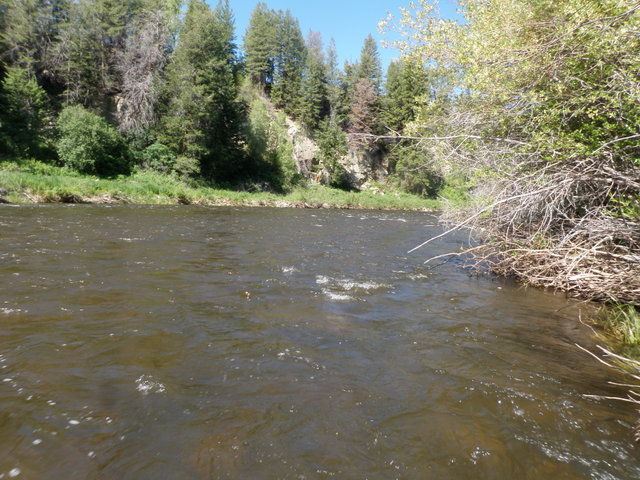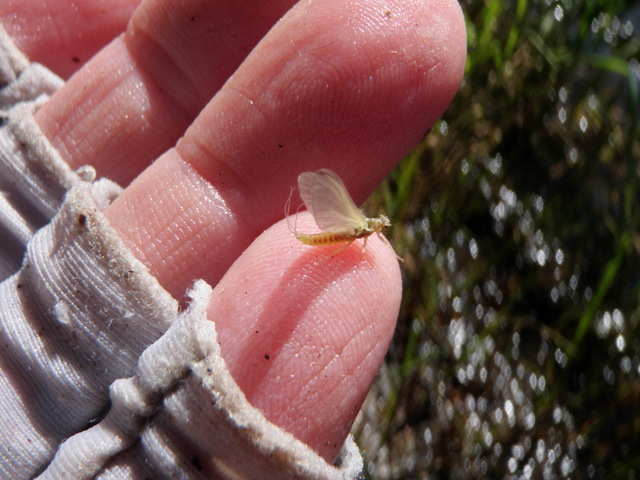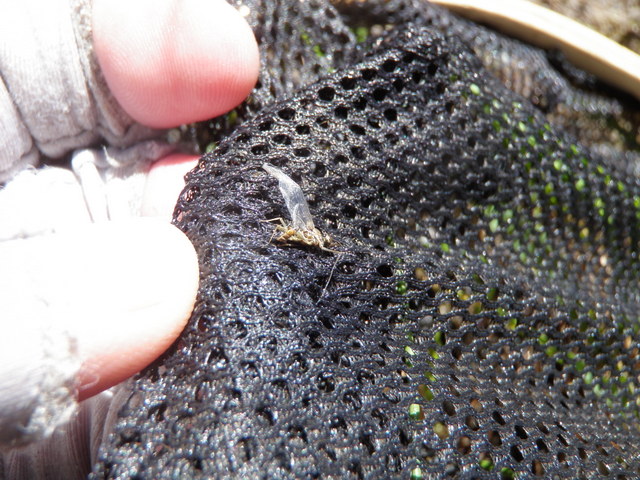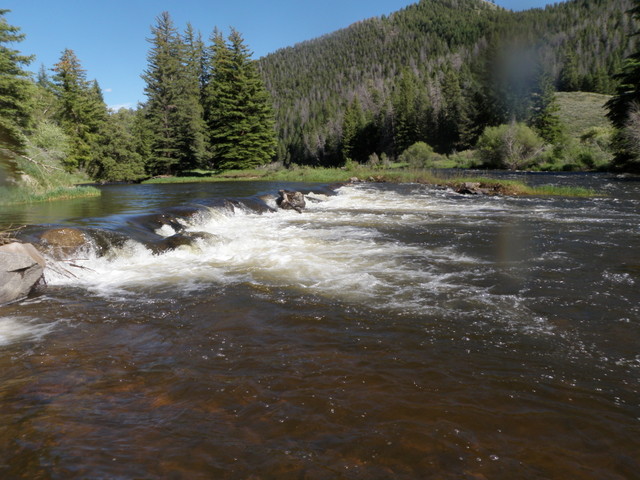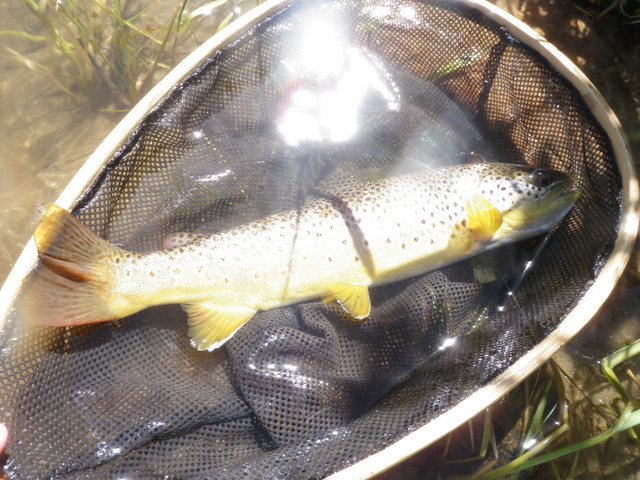Time: 9:00AM – 7:00PM
Location: Lone Buck access at Hot Sulfur Springs State Wildlife Area
Fish Landed: 7
Colorado River 06/30/2014 Photo Album
David Luther called early during the week of June 23 to remind me that he and his family would be in Winter Park from June 28 – July 2, and he invited Jane and I to join them for a few days. He was particularly interested in collaborating on some fishing. Fortunately Jane and I planned to return from our camping trip to the Frying Pan River on Saturday, so a trip to Winter Park fit in our plans. I called David back and asked if we could drive to their condo on Sunday and do some activities and then make Monday a fishing day. David approved of the plan and sent us directions to the condo.
On Sunday morning Jane and I packed our suitcases, bicycles, and fishing gear; and we departed for the Indian Peaks Resort. The Luther’s vacation condo was actually near Fraser, CO, but the town of Winter Park was only four miles away. It was a gorgeous day in the mountains and actually on the cool side. Since it was not a fishing day for David, his wife Becky was in charge of choosing an activity. Jane and I suggested a bike ride from Fraser to Winter Park and back, and Becky quickly embraced this idea. We jumped in our cars and drove to a bicycle rental shop on the southern edge of Fraser, and the Luthers rented cruisers and helmets.
We were right next to the trail, so once their seats were adjusted, we began our leisurely ride to Winter Park. It turned out to be a fun afternoon as we stopped at a restaurant in Winter Park for lunch and then continued on to Winter Park ski area where we rode the Zephyr lift to the top of the mountain. Here we found a snow bank and posed for photos and watched some crazy mountain bikers cruise down upper Hughes at a high rate of speed. Apparently youth knows no fear.
For our return trip David and his daughter Sarah and I biked on the Fraser River Trail, and it twisted and turned around several lakes and along the Fraser River. David L. and I were both scouting the stream as a possibility for Monday’s fishing expedition. It was high but clear with numerous slack water areas that appeared to be fishable despite the runoff level. When we returned the bikes, we spoke to the gentleman manning the fly shop and asked for his suggestion on where to fish the next day. He was hesitant to suggest a spot, but he did mention the upper Colorado River at the downstream end of Byers Canyon as a solid choice. When we returned to the condo, David L. and I researched stream flows on the various options and also reviewed several fly shop reports. We concluded that the upper Colorado was probably our best bet from a stream flow perspective, so that became our destination.
We woke up fairly early on Monday, and Jane departed quickly so she could make a 9:30 tennis match. David L. and I ate a light breakfast and then prepared lunches for our day on the river. I drove the Santa Fe so Becky and Sarah could use the rental car, and we reached Hot Sulphur Springs and the bottom of Byers Canyon by 8:30. We stopped and looked into the canyon, but we decided to move on as the steep canyon walls would probably shade the water until noon, and we wanted more warmth and daylight. A short distance beyond the bridge over Byers Canyon we found a turn off to Lone Buck access, and we descended a steep rough dirt road to the river and then made a left turn and drove to a small turnaround.
I straddled a fire pit for my parking space in order to get off the turnaround, and then David L. and I prepared to fish. Almost instantly mosquitoes began to swarm around David L.’s head so we both doused ourselves in sunscreen and insect repellent. Once we were geared up, we hiked on the dirt road and then cut down to an irrigation canal that paralleled the river. A path along the canal provided us additional downstream access, but eventually after a 20 minute hike we encountered a fence and a no fishing sign, and this is where we began our fishing day.
David L. committed to streamers and added a weighted head to his line to improve the sink rate. In contrast, I elected to fish with a Chernobyl ant and a beadhead hares ear nymph and began to move upstream along the bank seeking slack areas where fish could escape the high and slightly stained water. The flows were actually around 750 cfs, and for a large stream bed like the Colorado that is not extreme, but the water was moving at a fairly rapid pace in the middle of the channel. The Chernobyl and hares ear did not produce as I covered a fair amount of water and began to despair that there were no fish in this wide stretch of river. I read several articles that said the Colorado above the confluence of the Williams Fork was suffering due to withdrawals for the Front Range and the warming impact of the shallow Windy Gap Lake.
By eleven o’clock I began to notice a few mayflies emerging along the edge of the river and after ten minutes or so the intensity of the hatch increased. In fact between 11 and 12:30 I fished through an intense pale morning dun hatch. There were emergers and cripples and duns all over the surface, but the fish didn’t seem to be interested. Initially I tried adding a pheasant tail nymph as a dropper, but it had no impact. When greater numbers of duns appeared on the surface, I converted to a single light gray comparadun; the fly that has served me well on the Colorado River during PMD hatches later in the summer. I spotted two or three surface rises, but that was the extent of surface interest despite an intense hatch that lasted 1.5 hours. Toward the end of the hatch I spotted a cinnamon colored parachute dun in my front pack that I’d purchased for the PMD hatch on the Frying Pan River, so I clipped off the ineffective comparadun and replaced it with the purchased fly.
Much to my surprise as I drifted the fly to my right in some slightly faster water, a fish rose and sucked it in. I played the fish for a brief period and then my line went limp, and when I reeled it up, I discovered that the fly was gone as apparently I’d tied a poor knot.
When the pale morning dun hatch ended, I tied on a yellow Letort hopper as I hoped it might imitate a golden stonefly, as I spotted these large insects during visits in previous years. I also exchanged the hares ear nymph for an iron sally since one report suggested that yellow sallies were beginning to appear. Finally after an hour or two of fishing, a small brown snatched the iron sally, and I had my first fish of the day. Shortly after this bit of action, I added a salvation nymph as my third fly, and this produced a chunky eleven inch rainbow.
Unfortunately these two fish would be my only catches during three and a half hours of intense morning fishing. Finally David L. appeared with a big grin on his face, and we decided to walk back to the car for our lunches. David L. informed me that he had a great morning and landed at least six fish including quite a few in the fifteen inch range. He showed me his streamer, and it was an ugly olive concoction with a wide pearl chenille body.
After lunch I decided to jump on the streamer bandwagon, so I stashed my four weight Sage in the Santa Fe and got out my Loomis five weight. I swapped my floating line for a sinking tip line and extended the short 0X leader with some additional 2X. David L. looked at my streamer box and pointed to a sculpzilla that I purchased for my Argentina trip, so I tied the big olive weighted monstrosity to my short heavy leader. I was now prepared to go deep and ugly.
David L. negotiated a crossing of the wide river so he could reach a deep drop off near the opposite bank. His ability to cross was proof that the river had recently descended to manageable levels for fishing. I meanwhile circled back to the area I’d fished in the morning with my ineffective dry/dropper combination. I now concluded that I was not getting deep enough, and the water remained too high and cold for fish to be looking for food on the surface.
I began working the sculpzilla in a variety of techniques including tossing upstream and allowing to dead drift, throwing three quarters upstream and allowing it to swing, and stripping as the streamer reached the end of its drift. I even executed a dangle and simply allowed the streamer to hang and pulse downstream. It wasn’t long before I felt a tug shortly after I dropped the big ugly in some frothy water behind an exposed boulder, and I set the hook and battled a nice hard fighting fish. The fish charged downstream and circled back up toward the hooking point, and then streaked downstream a second time. Once I stopped the run, the fish made a sharp stop and turn and the fly line fell limp. How could a trout escape such a large hook? I can’t answer my own question, but the fish did in fact fight for and achieve its freedom.
I continued working the streamer with renewed focus and felt another tap on the swing, and then also experienced multiple taps on the dangle. I lost confidence in the sculpzilla so I switched to a large dragonfly nymph. This had a wide body like the Luther streamer, but did not contain any flash. The dragonfly nymph was a bust so I next tied on a big black woolly bugger with a beadhead and flashabou strands in the tail. Again I found myself simply exercising my arm. I was observing a fair number of caddis on the shrubs along the river, and each time I pushed aside a branch so I could move upstream, several would flit over the river.
I decided to tie some tippet to the bend of the woolly bugger and add a second fly; an emerald caddis pupa. I’m guessing this was an unconventional approach, but it was a combination of streamer fishing and wet fly swinging. Much to my surprise this method yielded two decent brown trout and in both cases I cast to the very top of a long run, and the fish nabbed the caddis pupa as it began to drag downstream with the current.
I stuck with the bugger and caddis combination for much of the remainder of the afternoon until I reached a three foot waterfall just below a small midstream island. It was now late afternoon and the sky clouded up a bit and I didn’t feel like continuing further so I retreated to the car. I’d moved through some very attractive water next to the bank so I decided to revert back to my dry/dropper approach for the remainder of the evening. I secured my Loomis five weight back in the case, and extracted the Sage that remained in the back of the Santa Fe. At least I would not need to take time to rebuild my rod and line.
For the next several hours I worked my way back upstream from the Santa Fe to beyond the waterfall with the Chernobyl ant and salvation nymph. I covered quite a bit of water, but I did have enough success to keep things interesting. Three nice browns were landed with each in the chunky 12-13 inch range. In addition I foul hooked two fish and had another nice fish that shed my fly.
By 7PM I’d gone 50 yards above the waterfalls, and the water above me did not appear to be very appealing so I began hiking back down to the car. Along the way I spotted David L. on the opposite bank working a girdle bug through likely holding spots. I motioned that I was returning to the car, and he signaled that he would cross and return as well.
It was a long day of fishing and I only landed seven fish in ten hours, but I experimented with some streamers and had some fun with the dry/dropper combination late in the day. David L. proved to me that streamers can be quite effective, and I was pleased to discover that the Colorado River above the Williams Fork confluence does hold a fair number of decent fish.


